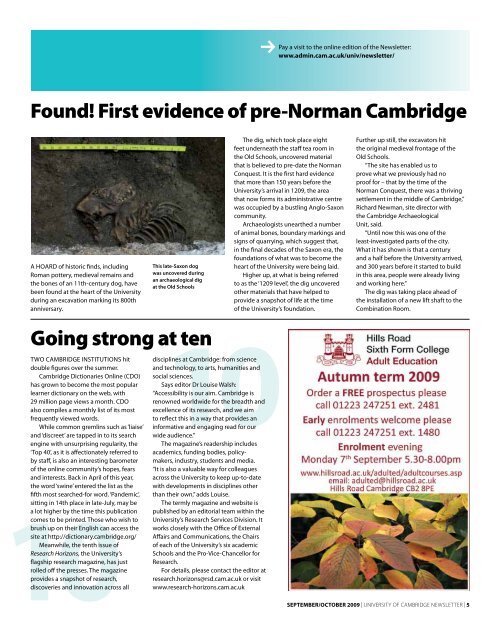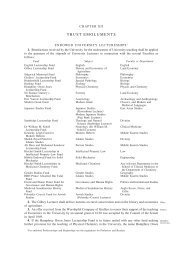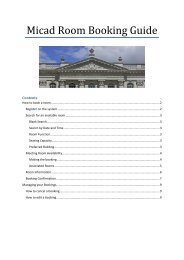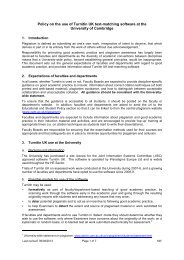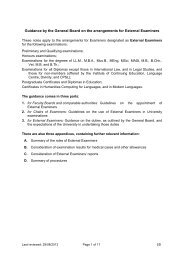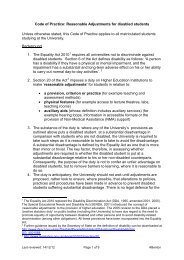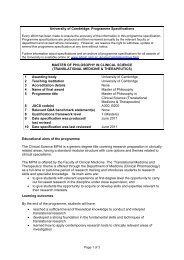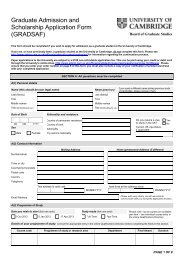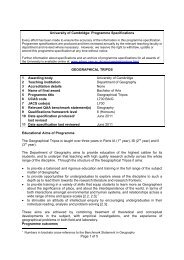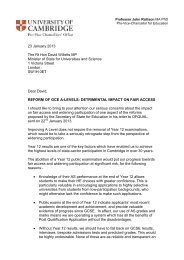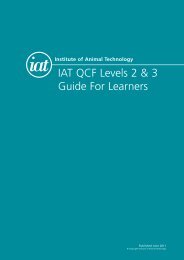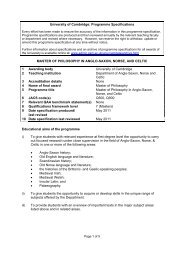Open Cambridge - the University Offices - University of Cambridge
Open Cambridge - the University Offices - University of Cambridge
Open Cambridge - the University Offices - University of Cambridge
You also want an ePaper? Increase the reach of your titles
YUMPU automatically turns print PDFs into web optimized ePapers that Google loves.
Pay a visit to <strong>the</strong> online edition <strong>of</strong> <strong>the</strong> Newsletter:<br />
www.admin.cam.ac.uk/univ/newsletter/<br />
Found! First evidence <strong>of</strong> pre-Norman <strong>Cambridge</strong><br />
A hoard <strong>of</strong> historic finds, including<br />
Roman pottery, medieval remains and<br />
<strong>the</strong> bones <strong>of</strong> an 11th-century dog, have<br />
been found at <strong>the</strong> heart <strong>of</strong> <strong>the</strong> <strong>University</strong><br />
during an excavation marking its 800th<br />
anniversary.<br />
This late-Saxon dog<br />
was uncovered during<br />
an archaeological dig<br />
at <strong>the</strong> Old Schools<br />
The dig, which took place eight<br />
feet underneath <strong>the</strong> staff tea room in<br />
<strong>the</strong> Old Schools, uncovered material<br />
that is believed to pre-date <strong>the</strong> Norman<br />
Conquest. It is <strong>the</strong> first hard evidence<br />
that more than 150 years before <strong>the</strong><br />
<strong>University</strong>’s arrival in 1209, <strong>the</strong> area<br />
that now forms its administrative centre<br />
was occupied by a bustling Anglo-Saxon<br />
community.<br />
Archaeologists unear<strong>the</strong>d a number<br />
<strong>of</strong> animal bones, boundary markings and<br />
signs <strong>of</strong> quarrying, which suggest that,<br />
in <strong>the</strong> final decades <strong>of</strong> <strong>the</strong> Saxon era, <strong>the</strong><br />
foundations <strong>of</strong> what was to become <strong>the</strong><br />
heart <strong>of</strong> <strong>the</strong> <strong>University</strong> were being laid.<br />
Higher up, at what is being referred<br />
to as <strong>the</strong> ‘1209 level’, <strong>the</strong> dig uncovered<br />
o<strong>the</strong>r materials that have helped to<br />
provide a snapshot <strong>of</strong> life at <strong>the</strong> time<br />
<strong>of</strong> <strong>the</strong> <strong>University</strong>’s foundation.<br />
Fur<strong>the</strong>r up still, <strong>the</strong> excavators hit<br />
<strong>the</strong> original medieval frontage <strong>of</strong> <strong>the</strong><br />
Old Schools.<br />
“The site has enabled us to<br />
prove what we previously had no<br />
pro<strong>of</strong> for – that by <strong>the</strong> time <strong>of</strong> <strong>the</strong><br />
Norman Conquest, <strong>the</strong>re was a thriving<br />
settlement in <strong>the</strong> middle <strong>of</strong> <strong>Cambridge</strong>,”<br />
Richard Newman, site director with<br />
<strong>the</strong> <strong>Cambridge</strong> Archaeological<br />
Unit, said.<br />
“Until now this was one <strong>of</strong> <strong>the</strong><br />
least-investigated parts <strong>of</strong> <strong>the</strong> city.<br />
What it has shown is that a century<br />
and a half before <strong>the</strong> <strong>University</strong> arrived,<br />
and 300 years before it started to build<br />
in this area, people were already living<br />
and working here.”<br />
The dig was taking place ahead <strong>of</strong><br />
<strong>the</strong> installation <strong>of</strong> a new lift shaft to <strong>the</strong><br />
Combination Room.<br />
Going strong at ten<br />
Two <strong>Cambridge</strong> institutions hit<br />
double figures over <strong>the</strong> summer.<br />
<strong>Cambridge</strong> Dictionaries Online (CDO)<br />
has grown to become <strong>the</strong> most popular<br />
learner dictionary on <strong>the</strong> web, with<br />
29 million page views a month. CDO<br />
also compiles a monthly list <strong>of</strong> its most<br />
frequently viewed words.<br />
While common gremlins such as ‘liaise’<br />
and ‘discreet’ are tapped in to its search<br />
engine with unsurprising regularity, <strong>the</strong><br />
‘Top 40’, as it is affectionately referred to<br />
by staff, is also an interesting barometer<br />
<strong>of</strong> <strong>the</strong> online community’s hopes, fears<br />
and interests. Back in April <strong>of</strong> this year,<br />
<strong>the</strong> word ‘swine’ entered <strong>the</strong> list as <strong>the</strong><br />
fifth most searched-for word. ‘Pandemic’,<br />
sitting in 14th place in late-July, may be<br />
a lot higher by <strong>the</strong> time this publication<br />
comes to be printed. Those who wish to<br />
brush up on <strong>the</strong>ir English can access <strong>the</strong><br />
site at http://dictionary.cambridge.org/<br />
Meanwhile, <strong>the</strong> tenth issue <strong>of</strong><br />
Research Horizons, <strong>the</strong> <strong>University</strong>’s<br />
flagship research magazine, has just<br />
rolled <strong>of</strong>f <strong>the</strong> presses. The magazine<br />
provides a snapshot <strong>of</strong> research,<br />
discoveries and innovation across all<br />
disciplines at <strong>Cambridge</strong>: from science<br />
and technology, to arts, humanities and<br />
social sciences.<br />
Says editor Dr Louise Walsh:<br />
“Accessibility is our aim. <strong>Cambridge</strong> is<br />
renowned worldwide for <strong>the</strong> breadth and<br />
excellence <strong>of</strong> its research, and we aim<br />
to reflect this in a way that provides an<br />
informative and engaging read for our<br />
wide audience.”<br />
The magazine’s readership includes<br />
academics, funding bodies, policymakers,<br />
industry, students and media.<br />
“It is also a valuable way for colleagues<br />
across <strong>the</strong> <strong>University</strong> to keep up-to-date<br />
with developments in disciplines o<strong>the</strong>r<br />
than <strong>the</strong>ir own,” adds Louise.<br />
The termly magazine and website is<br />
published by an editorial team within <strong>the</strong><br />
<strong>University</strong>’s Research Services Division. It<br />
works closely with <strong>the</strong> Office <strong>of</strong> External<br />
Affairs and Communications, <strong>the</strong> Chairs<br />
<strong>of</strong> each <strong>of</strong> <strong>the</strong> <strong>University</strong>’s six academic<br />
Schools and <strong>the</strong> Pro-Vice-Chancellor for<br />
Research.<br />
For details, please contact <strong>the</strong> editor at<br />
research.horizons@rsd.cam.ac.uk or visit<br />
www.research-horizons.cam.ac.uk<br />
september/october 2009 | UNIVERSITY OF CAMBRIDGE Newsletter | 5


